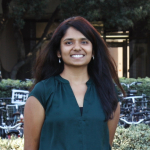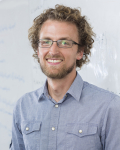Spotlights
Fall 2017: Chitra Karanam

Chitra Karanam is a Ph.D. student working under the guidance of Professor Yasamin Mostofi in the Electrical and Computer Engineering department at the University of California Santa Barbara. She received her B.Tech and M.Tech degrees in Electrical Engineering from the Indian Institute of Technology Madras in 2014, and her M.S. in Electrical and Computer Engineering from University of California Santa Barbara in 2016. Her research is in the field of RF sensing and robotics. She is currently working on using unmanned vehicles and drones for 3D through-wall imaging with RF signals such as WiFi.
Chitra's advisor, Yasamin Mostofi, wished to say a few words about her contributions to the lab: "Chitra has been working on imaging through walls with WiFi and drones for the past couple of years in my lab. This is an extremely challenging problem at the intersection of robotics and communications. It further requires both theoretical expertise and experimental developments, a combination that may not be of interest to many students. Chitra has done great on this project, contributing to through-wall sensing fundamentals while developing the needed hardware to test new methodologies. I am proud of her accomplishments."
In Chitra’s spare time she can be found out on a local hiking trail or playing squash with friends. In her down time she likes to read and relax.
Exceptionally Fine-Tuned

The 2017 ShanghaiRanking places UCSB at No. 3 in the world in the field of automation and control
With smart homes, self-driving cars and other technology making the world an ever more automated place, state-of-the-art automation and control has become essential. And UC Santa Barbara is among those leading the way.
In its Academic Ranking of World Universities’ (ARWU) 2017 global ranking by academic subjects, the ShanghaiRanking places UCSB at No. 3 in the world in the field of automation and control, just behind University of Illinois at Urbana-Champaign and Massachusetts Institute of Technology.
“This is a wonderful recognition of the important, first-rate work our distinguished colleagues are doing, and such recognition brings prestige and distinction to the entire college and our campus,” said UCSB Chancellor Henry T. Yang.
The beauty of automation and control lies in its invisibility: If things are working well, people usually don’t notice. Automation and control makes trains run on time, directs stoplights to change from green to yellow to red, lets our cars know when to switch gears and is responsible for making sprinklers come on to douse the flames when a fire breaks out in a room. Automation and control makes our world run smoothly and safely, encompassing a variety of fields, including aviation, transportation, biomedical applications and virtually every situation in which a machine must sense and respond to variable input with minimal human intervention.
At UCSB, experimental and theoretical work in automation and control is pursued on several fronts. Among them are the dynamics and control of airplane and space structures; control of building structures due to earthquakes and winds; control of switched and discontinuous systems and automatic drive-train control.
More than 4,000 universities were ranked across 52 subjects for the 2017 ARWU list. Indicators include measures of research productivity, research quality, extent of international collaboration and research with top quality and the highest academic recognitions.
“This is great news confirming the outstanding quality of our program in control and automation, an area of increasing importance to improving quality of life in our technologically complex world,” said UCSB College of Engineering Dean Rod Alferness. “The fact that the ShanghaiRanking group has chosen to highlight this field and rank our program number three in the world validates our vision of investing in such cutting-edge, high-impact areas of endeavor."
By Sonia Fernandez
Tour of the Controls Lab at UC Santa Barbara
Justin Pearson gives a tour of the undergraduare controls lab at UCSB for incoming first-year undergraduate students in Electrical and Computer Engineering and plays around with an inverted pendulum.
Summer 2017: Philip Brown

Philip Brown is a Ph.D student from Colorado who has been working under Faculty member Jason Marden. His research focuses on the consequences of ignoring information in multi-agent systems. After receiving his B.S. in Electrical Engineering from Georgia Tech he went on to help start a biodiesel production company in Tennessee. In 2012 he went back to school to receive his M.S from the University of Colorado before transferring here to UCSB. His advisor Jason Marden writes:
“It is widely known that social systems can exhibit highly inefficient system-level behavior. Accordingly, there has been a significant research focus on the derivation of mechanisms for influencing social behavior to improve the efficiency of such systems. Philip's research has sought to address the robustness of these influencing mechanisms. More formally, is it possible to successfully influence a given social system in situations where a system-operator has uncertainties pertaining to how the actors in a society will respond to the influencing mechanisms. Focusing on the role of taxation mechanisms in transportation networks, Philip's results have identified how the information available to the system operator, pertaining to both the characteristics of the underlying network and the population's sensitivities to taxes, directly ties into the system operator's ability to do this essential task.”
Brown’s long-term goals are to collaborate with economists and computer scientists to gain a better understanding on the impact of social behavior on engineering design criteria. In his downtime he can be found on long runs or at his house making beer, wine, and bread for friends.
Prof. Yasamin Mostofi Lab’s research on 3D through-wall imaging

UCSB researchers propose a new method for 3D through-wall imaging that utilizes drones and WiFi
Researchers at UC Santa Barbara professor Yasamin Mostofi’s lab have given the first demonstration of three-dimensional imaging of objects through walls using ordinary wireless signal. The technique, which involves two drones working in tandem, could have a variety of applications, such as emergency search-and-rescue, archaeological discovery and structural monitoring.
“Our proposed approach has enabled unmanned aerial vehicles to image details through walls in 3D with only WiFi signals,” said Mostofi, a professor of electrical and computer engineering at UCSB. “This approach utilizes only WiFi RSSI measurements, does not require any prior measurements in the area of interest and does not need objects to move to be imaged.”
The proposed methodology and experimental results appeared in the Association for Computing Machinery/Institute of Electrical and Electronics Engineers International Conference on Information Processing in Sensor Networks (IPSN).
In their experiment, two autonomous octocopters take off and fly outside an enclosed, four-sided brick house whose interior is unknown to the drones. While in flight, one copter continuously transmits a WiFi signal, the received power of which is measured by the other copter for the purpose of 3D imaging.
After traversing a few proposed routes, the copters utilize the imaging methodology developed by the researchers to reveal the area behind the walls and generate 3D high-resolution images of the objects inside. The 3D image closely matches the actual area.
“High-resolution 3D imaging through walls, such as brick walls or concrete walls, is very challenging, and the main motivation for the proposed approach,” said Chitra R. Karanam, the lead Ph.D. student on this project.
This development builds on previous work in the Mostofi Lab, which has pioneered sensing and imaging with everyday radio frequency signals such as WiFi. The lab published the first experimental demonstration of imaging with only WiFi in 2010, followed by several other works on this subject.
Their previous 2D method utilized ground-based robots working in tandem, the success of the 3D experiments is due to the copters’ ability to approach the area from several angles, as well as to the new proposed methodology developed by her lab.

